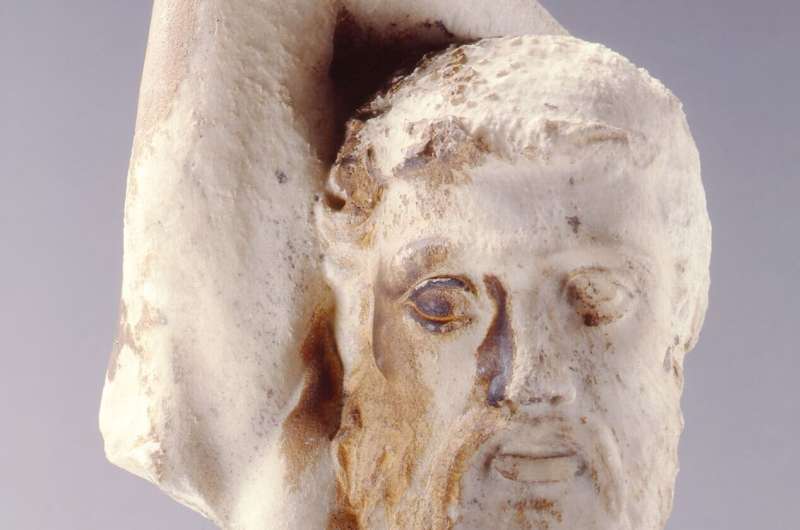
A centaur head and two more marble fragments taken from the Parthenon in the 17th century are among the most popular exhibits of the National Museum in Denmark.
The head originally belonged to a centaur figure and was part of a scene depicting the Greek mythological Lapiths’ battle against the centaurs, the mythical creatures that were half-horse, half-human.
The centaur head, along with another head from the Parthenon temple and a horse’s hoof, came to Denmark in 1688 as a gift to King Christian V.
It was brought by the Danish captain Moritz Hartmand, who served in the Venetian fleet and was present during the bombardment of the Acropolis in Athens in 1687. A significant part of the Parthenon temple was destroyed.
The centaur head was placed in the Royal Kunstkammer, which later became the National Museum, where it has been exhibited ever since.
Denmark to keep the centaur head and fragments of Parthenon Marbles
Despite calls for the re-unification of the Parthenon Marbles, Denmark insists that the artifacts will remain in Copenhagen.
Last November, Dr. Rane Willerslev, the Danish museum’s director, claimed that “after careful consideration, [the fragments] are of greater importance to the National Museum than if they were sent to Greece.”
While the majority of surviving fragments remain divided between Athens and London, the National Museum’s Head of Research, Dr. Christian Sune Pedersen, added that the three fragments on display in Copenhagen are of “great importance for Danish cultural history and for understanding our interaction with the world around us at a time when democracy was taking shape.”
“It is important for Danes to know Denmark’s place in European history. There have always been interactions between countries, and this has had a huge cultural impact on who we are today. The National Museum of Denmark owns a very small part of the total preserved sculpture fragments of the Parthenon Temple, which are of great importance for understanding our own history in the world,” the historian added.
Mystery of the brown film on the centaur’s head
Scientists have been struggling to solve the mystery of why parts of the centaur head are coated with a thin brown film, as are several other marble fragments from the Parthenon.
Originally it was thought that it might be a result of a chemical reaction between the marble and the air, or that the marble contained iron particles that had migrated to the surface, coloring it brown.
In a study published in Heritage Science, scientists that were allowed to take five small samples from the back of the centaur head concluded that there was no biological matter in the brown layers.
“We found no traces of biological matter in the brown layers—only from our own fingerprints and perhaps a bird egg that broke on the marble in ancient times. This doesn’t prove that there never was a biological substance, but it significantly reduces the probability, making the theory of a biological organism less probable now,” says Kaare Lund Rasmussen, one of the authors.
Similarly, it is now less probably that the marble surface was painted or preserved, according to the researchers, who also specifically searched for traces of paint. Ancient paints were typically based on natural products such as eggs, milk, and bones, and no traces of such ingredients were found in the brown stain alone.
The mystery remains
Through their investigations, the research team also discovered that the brown film consists of two separate layers. These two layers are approximately equally thick, around 50 micrometers each, and they differ in terms of trace element composition. However, both layers contain a mixture of the oxalate minerals weddellite and whewellite.
The fact that there are two distinct layers argues against the theory that they were created by the migration of material, such as iron particles, from the interior of the marble. It also contradicts the theory that they resulted from a reaction with the air.
Air pollution is also unlikely for another reason; the centaur head has been indoors in Copenhagen since before modern industrialization began in the 18th century. In fact, this makes the heads at the National Museum particularly valuable compared to the marble pieces on the Acropolis, of which some have only recently been brought indoors.
“As there are two different brown layers with different chemical compositions, it is likely that they have different origins. This could suggest that someone applied paint or a conservation treatment, but since we haven’t found traces of such substances, the brown color remains a mystery,” concludes Kaare Lund Rasmussen.
See all the latest news from Greece and the world at Greekreporter.com. Contact our newsroom to report an update or send your story, photos and videos. Follow GR on Google News and subscribe here to our daily email!



